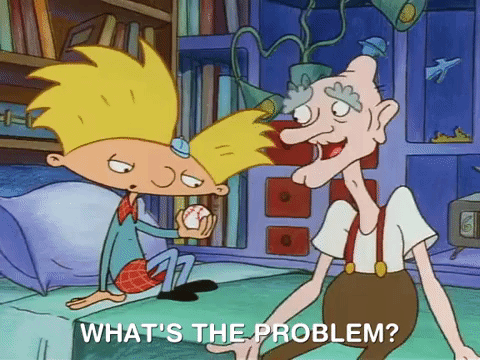With a project proposal, you present a solution to a problem your potential client has defined, the budget for the project, the ideal timeline, and other relevant information.
Animation project proposals are usually agreed on and signed after several conversations between you and your client.
It may seem unnecessary and frustrating to write an animation proposal when you already have an idea how to start a project; however, writing one will serve as your guide and provide you with structure as you work on the project.
When writing a project proposal, you must make your proposal stand out. Include everything your client wants to know and things they never knew they needed for their video.
Packing all this information into a relatively short proposal may seem daunting! But we’re here to help: Here are 8 tips for writing an animation project proposal.
1) Talk About Yourself

GIF by NickRewind via GIPHY
Include a brief description of who you are, what you do, and what you specialize in.
Include some client testimonials and a few images or videos from your portfolio that are related to the project, so the client has evidence of how you work and what you do.
2) Define the Problem and the Goals

GIF by Hey Arnold via GIPHY
State the goals and objectives for the animation project. Define the problem and explain how your animation skills and your video will solve the problem.
Make sure you know what goals and objectives your client aims to reach. What does your client want their audience to do after watching the video?
- Do they want to gain a certain number of followers on social media?
- Do they want an increase in website traffic and social media engagement?
- Is the video meant to increase sales by X% in a specific amount of time?
- Do they want to inform, remind, or persuade their audience?
3) Define the Audience

Image by La Guarimba Film Festival via GIPHY
Usually, one of the first questions animators ask when making a video for a client is: Who it is for?
When defining the audience of your client’s video, here are some questions to guide you and your client:
- What is the age group of your client’s target audience for the video?
- What kind of mindset will they have when they watch your video?
- Should the video have a casual or formal tone?
- What kind of video do you think they will be attracted to?
- Will viewers have an idea about your products and services already before watching the video?
In your proposal, make sure you clearly identify and define the target audience.
4) Know the Competitors

GIF by America’s Next Top Model via GIPHY
Before you make a video, it’s important you know who your client’s competitors are. Observe what kinds of fonts, storylines, characters, tones, animation styles, etc. they use. What parts of their videos do you and your client like and dislike?
Knowing the kind of videos your client’s competitors create will give you a better picture of what kind of video you should make, so your client’s video stands out. Then you should clearly state in your proposal how you plan to do this.
This is also a good way to show your client that you’re truly concerned about them and will help them grow their business.
5) Give Solutions and Outcomes

GIF by SpongeBob SquarePants via GIPHY
When you understand your client’s goals, audience, and competitors, it’s time to give your animation client your proposed solution.
This is where you tell your client the way(s) you can help them reach their business goals. Also tell them what results they should expect from your animation project.
You may include testimonials from your best clients to show how your ideas and efforts helped your previous clients’ brand awareness and sales. Not only will this provide evidence that you can deliver on your proposed product and solution, but it will also show your client that you have enough animation experience and background to do the project.
6) Set a Project Timeline and Deliverables

When giving a timeline, don’t set specific dates, hours, and months. Instead, provide time blocks. For example, a day, 3 days, 7 days, etc.
Let your client know your process: How many hours in a day you usually work, how many days in a week you work, how long it usually takes you to finish a project, etc.
Including Gantt charts and tasks for both you and your animation client can be very helpful, so you can easily monitor the progress of your project.
Also, clearly set the budget and payment methods. This will help minimize miscommunication between you and your client.
7) Present a Quote

Image by Van Tay Media via Unsplash
In this part of the animation project proposal, include pricing and different packages you offer of your services.
When outlining different packages and their pricing, provide a package that fits your client’s exact needs, a package with minimum costs, and a package that has great value, so the client has options and can select a package that best fits their priorities.
Include the pricing terms and payment deadlines. Don’t overestimate the costs; you don’t want to scare away your potential animation clients with high figures. But also, be careful to not undervalue your work and time. Plan in case there are unexpected issues and prices down the line.
8) Write the Proposal

GIF by Kids’ Choice Awards via GIPHY
Now you know what to include in a proposal. So how will you write it? There are several methods! Here are some options you can choose from:
Build a Proposal Yourself
You can create the layout, write all the copy, and add images by yourself. This is perfect for people who want to customize their proposals and add their personality into it. Building your proposal yourself can help you stand out. But make sure you have a good grasp on the basics of what potential clients expect for proposal’s formatting and copy.
Download a Template
The second option is to download a template from the internet. This will save you time and give you an idea of how to lay out all the necessary information needed in your proposal. All you need to do is type or copy and paste your specific details into the template, then save it.
Use Applications
If you want to automate the process, you can use some applications out there like Prospero, created by Ran Segall, which allows you to easily create a proposal and send it to your client in just 5 to 8 minutes.
Wrapping It Up
Sending a proposal to your client is one of the first ways you will communicate with them.
It can be overwhelming and take a lot of time, but thanks to templates and automated apps, you don’t necessarily have to make project proposals on your own.
When writing a proposal, always define the purpose and objectives of your animated project, research your market, present a quote, set a timeline, and provide solutions.
If you’re looking for more tips and advice about the business side of animation as a freelance animator, make sure to check out our free marketing handbook and sign up for our masterclass.



